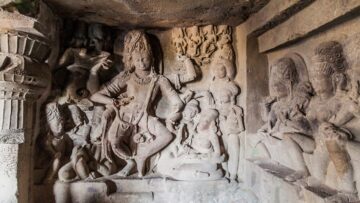Abstract
In this paper, first, the mainstream Sustainable Development literature is studied to identify key historical attributions of the concept currently in vogue. In light of specific evidence from the critical edition of the Mahābhārata, an Indic case is posited for revisiting one of the key attributions in the mainstream Sustainable Development literature.
Introduction
Correlating ‘sustainable development’ to Indic texts, particularly Sanskrit texts, is an evolving domain. Some previous works in this area include Bhalachandran’s 2011 paper Kautilya’s model of sustainable development[1], Mausumi Bhattacharjee’s chapter Concept of Sustainable Development in the Mahābhārata[2] (in her 2012 thesis Environmental concept as reflected in the Mahabharata its relevance in the modern world[3]) and Yamini Narayanan’s 2013 paper Inspiring Sustainability beyond Sustainability: Sustainable Development and the Ultimate Hindu Purpose[4]. On the related (and in some ways broader yet in some other ways narrower) topic—of looking at Indic texts for textual evidence of protection, praise, worship and conservation of different aspects of the environment—there exists, now, not only a Central Board for Secondary Education (CBSE) education module titled Indian Traditional Knowledge on Environmental Conservation[5] but also at least one dedicated digital space: ENVIRONMENTAL STUDIES[6], in the Vedic Heritage portal maintained by the Ministry of Culture, Government of India. Other examples of broadly related [and relatively earlier: around the turn of the century (1998-2002)] impulses include literature related to uncovering insights pertaining to ‘Biodiversity conservation’: from Manu-Samhita[7] to Indian traditions[8] and traditional knowledge systems[9]. Cross-civilizational comparative perspectives, though seemingly fewer, have also now emerged: Michel Danino’s Nature in Indian and Western Traditions (and For the Love of Nature)[10] and Vishwa Adluri’s Unburdening the Earth: Hinduism and Ecology[11] make for trenchant reading, foregrounding perspectives from Indic texts and contrasting them to non-Indic ones, across millennia. Sustainable development is, though, not only about the environment and while the above survey is not comprehensive—even when seen from just the intersection of sustainable development and the environment—what follows in this paper will be an addition to the above literature whilst addressing the case outlined in the abstract.
From Sylva to the Mahābhārata
Sustainable development is not only about the environment. What is it, though? Author of Concept of Sustainable Development in the Mahābhārata, Mausumi Bhattacharjee presents a succinct overview[12], not just alluding to some globally influential definitions of the compound-term but also breaking the compound-term down to its component words, foregrounding some of their definitions and then synthesizing what she calls “the three most important objectives of sustainable development”:
As per the Chambers 20th Century Dictionary, the meaning of the word ‘sustain’ is to hold up, to bear, to support, to provide for, to maintain, to sanction, to keep going, to keep up, to support the life of, to prolong.[1] The word ‘development’, indicated by the Encyclopaedia of Ecology and Environment, Vol. 10 is “about improving the well-being of people”.[2] When the word ‘sustain’ is used as adjective to the word ‘development’, it means a continual process of growth or advancement. Over the last three decades, the term sustainable development has been defined in many ways, but one of the most popular definitions was coined by the World Commission on Environment and Development (The Brundtland Commission). The origin of this concept of sustainable development was pointed out in the World Conservation Strategy (WCS) Report, published in 1980.[3] The report of the Brundtland Commission (1987), Our Common Future has popularised and defined the term sustainable development as: “Sustainable development is development that meets the needs of the present without compromising the ability of the future generations to meet their own needs”. The concept of sustainable development is precisely stated in the Encyclopaedia of Ecology and Environment, Vol. 10 as “Development that lasts”.[4] It emphasises upon the balance between consumption and production of natural resources. It means that the well being of the (sic.) human beings depends on the judicious extraction, consumption, and utilisation of natural resources, maintaining the regenerating capacity of nature. The aims and objectives of sustainable development are to raise the living standard and qualities of the lives of the people of present as well as future generations while conserving the environment and natural resources. So, to secure economic well-being, social development and environmental stability are the three most important objectives of sustainable development.” (Bhattacharjee 2012:61)
Thereafter, while she goes on to correlate sustainable development with evidence—both direct and indirect—not just from the Mahābhārata and presents by and large a credible case, I will go down one path she has not: to look at the historical attributions in some of the mainstream sustainable development literature and present an Indic case for that attribution to be revised. While the Sustainable Development Commission’s[13] History of SD (see footnote 11) went as far back as Rachel Carson’s Silent Spring (1962), Alexandre André Feil and Dusan Schreiber, in their 2017 paper Sustainability and sustainable development: unraveling overlays and scope of their meanings[14], go back to John Evelyn’s Sylva (1664):
“The selected timeframe begins in the year 1664, with the publication of Sylva, by John Evelyn. It is considered that with this work initiated the concern with environment depletion and economic development.” (Feil and Schreiber 2017:672; sic.)
Feil and Schreiber are neither alone nor first, in tracing back to John Evelyn’s Sylva (1664). About ten years earlier, Ulrich Grober’s 2007 paper Deep roots – A conceptual history of ‘sustainable development’ (Nachhaltigkeit)[15] not only traces back to John Evelyn’s Sylva (1664) but also explicitly credits Evelyn’s work as a “17th century forerunner of the Brundtland report” (Grober 2007:11) and does not miss the opportunity to invoke the “era of early ‘European Enlightenment’”:
“The roots of this concept can be traced back to the era of early ‘European Enlightenment’, when German Kameralists, inspired by the English author John Evelyn and the French statesman Jean Baptist Colbert, began to plan their dynasties’ woodlands ‘nachhaltig’ – in order to hand them along undiminished to future generations. The word itself was then coined in 1713 by Hanns Carl von Carlowitz, head of the Royal Mining Office in the Kingdom of Saxony, in order to meet the challenge of a predicted shortage of timber, the key resource of the time.” (Grober 2007:3) [Emphasis added]
“Carlowitz had two important sources and models: A folio-sized book published in 1664 in London: John Evelyn’s ‘Sylva’, and….“ (Grober 2007:8)
“The soul of the project, however, was John Evelyn (1620 – 1706). He was put in charge of compiling the material and elaborating a proposal for the solution of the timber problem. Evelyn was one of the founding members and most active Fellows of the Society, a landed gentleman of elegant looks, far-travelled, conceited and pious. … Within two years after the oral discourse in the halls of the Royal Society, Evelyn had completed his book. On February 16, 1664 he presented to the King, the Royal Society and to the public his ‘Sylva or a Discourse of Forest Trees and the Propagation of Timber in His Majesties Dominions’. The book became a 17th century best-seller and instigated, according to Evelyn’s remarks in later editions, the planting of millions of trees all over England.“ (Grober 2007:8) [Emphasis added]
I will deal with portions emphasised above in the sequence they appear. That Grober invokes ‘European Enlightenment’ is highlighted to foreground the fact that this is one more in the list of attributions to European Enlightenment. As a very recent example, consider the following words of a globally influential academician, experimental psychologist, cognitive scientist and linguist based at Harvard University, Steven Pinker (author of Enlightenment Now, How the Mind Words and The Better Angels of our Nature) who associates “Reason” and “Science” themselves to the European Enlightenment:
“…Human nature hasn’t changed in the last couple of centuries, how did we manage to improve human life? There, I think, ideas matter. One of the key ideas that, or sets of ideas, that led to human improvement were the ideas that we associate with the Enlightenment: the use of reason to figure out the world as opposed to dogma or faith or authority. The attempt to understand the physical world by applying reason to it, or Science. The idea of Humanism…”[16]
If an academician at Harvard, in 2019, can associate Reason[17] and Science to European Enlightenment, should Feil and Schreiber be expected to use Google Search, in 2016, to explore other potential historical attributions of ‘Sustainable Development’ before 1664? If Pinker, Feil and Schreiber can be excused, Grober’s invocation of European Enlightenment, in 2007 or earlier, suddenly seems far less unacceptable. Now, onto to the second statement with emphasis (i.e., bolded) above: if it is not problematic enough that it is Evelyn’s own remarks (apparently in some of his later editions) which constitutes the evidence for ‘the planting of millions of trees all over England,’ at least the presumed impact of Evelyn’s 1664 work has been squarely criticised and roundly questioned in Arponen’s paper John Evelyn’s Sylv : Some Remarks on Its Circumstances of Production, Reception and Influence[18]:
“There is little explicit evidence to suggest that Sylva or Evelyn in person had a direct influence upon the English state to initiate plantings in its royal forests. In the Forest of Dean, for centuries one of the sources of English naval timber, the issue of the availability of naval timber had by the time of Sylva ’s publication been on the agenda for many decades already and it does not seem that the issue needed Evelyn as its publicist.” (Arponen 2012:20)
Yet, it is not just the Wikipedia link[19] for Sustainable Development[20] but also books such as Biochemistry and Forestry Management, published in 2019 by ETP (Ed-Tech Press, UK), that cite the same line attributed to Evelyn (in emphasis below):
“Sustainable development has its roots in ideas about sustainable forest management which were developed in Europe during the seventeenth and eighteenth centuries. In response to a growing awareness of the depletion of timber resources in England, John Evelyn argued that “sowing and planting of trees had to be regarded as a national duty of every landowner in order to stop the destructive overexploitation of natural resources”…” (Jacobs and Russell 2019:102)
Even if one were to allow for the possibility that Arponen’s critique might not be the last word (though I could find no takedown of his critique yet), the above trace has brought us to those words, attributed to Evelyn, to which all of ‘Sustainable Development’ is currently traced back to: “sowing and planting of trees had to be regarded as a national duty of every landowner in order to stop the destructive overexploitation of natural resources”. I posit that this attribution, to Evelyn, should be replaced by a far more comprehensive statement found in the critical edition of the Mahābhārata:
Verse[21]:
12087015a आशयाश्चोदपानाश्च प्रभूतसलिला वराः
12087015c निरोद्धव्याः सदा राज्ञा क्षीरिणश्च महीरुहाः (Belalkar 1961:413)
One translation:
जलाशय (तालाब, पोखरे आदि), उदपान (कुंए, बावड़ी आदि), प्रचुर जलराशिसे भरे हुए बड़े-बड़े तालाब तथा दूधवाले वृक्ष—इन सबकी राजाको सदा रक्षा करनी चाहिए (Śāstrī 2012: 276)
Let me be clear: I neither claim that the above verse is the most comprehensive statement about sustainable development in Indic texts nor do I claim that it is the oldest in world literature. I do, however, critique the current historical attribution, to Evelyn, for being eurocentric and myopic, particularly in the post-Google era, and propose that it be replaced by the above verse from the Mahābhārata until a more direct, more comprehensive and an older one is proposed, which I suspect, exists atleast in the Indic corpus[22]. This paper would succeed even more, in one of its objectives, if a more direct, more comprehensive and an older Indic statement (or statements) is proposed in the future in response to the above and goes on to supersede it.
Bibliography
Adluri, Vishwa. 2018. “Unburdening the Earth: Hinduism and Ecology.” 2018. https://www.academia.edu/28660228/Nature_in_Indian_and_Western_traditions.
Belvalkar, Shripad Krishna. 1961. THE ŚĀNTIPARVAN Being the Twelfth Book of the Mahābhārata THE GREAT EPIC OF INDIA. Poona: Bhandarkar Oriental Research Institute.
Bhalachandran, G. 2011. “Kautilya’s Model of Sustainable Development.” Humanomics 27 (1): 41–52. https://doi.org/10.1108/08288661111110169.
Bhattacharjee, Mausumi. 2012. “Environmental Concept as Reflected in the Mahabharata Its Relevance in the Modern World.” 2012. http://hdl.handle.net/10603/115378.
Danino, Michel. 2011. “Nature in Indian and Western Traditions.” 2011. https://www.academia.edu/28660228/Nature_in_Indian_and_Western_traditions.
Feil, Alexandre André, and Dusan Schreiber. 2017. “Sustentabilidade e Desenvolvimento Sustentável: Desvendando as Sobreposições e Alcances de Seus Significados.” Cadernos EBAPE.BR 15 (3): 667–81. https://doi.org/10.1590/1679-395157473.
Grober, Ulrich. 2007. “A Conceptual History of ‘Sustainable Development.’” https://bibliothek.wzb.eu/pdf/2007/p07-002.pdf.
Jain, S.K. 1997. “Some Aspects of Biodiversity and Indian Traditions.” Indian Journal of History of Science 33 (1). https://www.insa.nic.in/writereaddata/UpLoadedFiles/IJHS/Vol33_1_5_SKJain.pdf.
Narayanan, Yamini. 2013. “Inspiring Sustainability beyond Sustainability: Sustainable Development and the Ultimate Hindu Purpose.” Nature and Culture 8 (3): 301–23. https://doi.org/10.3167/nc.2013.080305.
Śāstrī, Rāmanārāyaṇadatta. 2012. महाभारत (पंचम खंड) शांति पर्व. Gorakhpur: गीता प्रेस (Gita Press).
Sensarma, Priyadarsan. 1998. “Conservation of Biodiversity in MANU-SAṂHITĀ.” Indian Journal of History of Science 33 (4). https://www.insa.nic.in/writereaddata/UpLoadedFiles/IJHS/Vol33_4_2_PSensarma.pdf.
[1] https://www.emerald.com/insight/content/doi/10.1108/08288661111110169/full/html. Accessed on May 12, 2020
[2] https://shodhganga.inflibnet.ac.in/bitstream/10603/115378/10/10_chapter%203.pdf. Accessed on May 12, 2020
[3] https://shodhganga.inflibnet.ac.in/handle/10603/115378. Though Bhattacharjee’s title includes the delimitation Mahābhārata, the textual data she includes in her thesis is hardly limited to the Mahābhārata. Accessed on May 12, 2020
[4] https://www.berghahnjournals.com/view/journals/nature-and-culture/8/3/nc080305.xml. Accessed on May 12, 2020
[5] http://cbseacademic.nic.in/web_material/Circulars/2012/68_KTPI/Module_5.pdf. Accessed on May 12, 2020
[6] http://vedicheritage.gov.in/environmental-studies/. Accessed on May 12, 2020
[7] https://www.insa.nic.in/writereaddata/UpLoadedFiles/IJHS/Vol33_4_2_PSensarma.pdf. Accessed on May 12, 2020
[8] https://www.insa.nic.in/writereaddata/UpLoadedFiles/IJHS/Vol33_1_5_SKJain.pdf. Accessed on May 12, 2020
[9] https://www.infinityfoundation.com/mandala/t_es/t_es_pande_conserve_frameset.htm. Accessed on May 12, 2020
[10] https://www.academia.edu/28660228/Nature_in_Indian_and_Western_traditions. Accessed on May 12, 2020
[11] https://www.academia.edu/41693117/Unburdening_the_Earth_Hinduism_and_Ecology?email_work_card=title. Accessed on May 12, 2020
[12] History of SD (http://www.sd-commission.org.uk/pages/history_sd.html) contains information which would expand Mausumi’s overview with some additional detail. Accessed on May 12, 2020
[13] “The Sustainable Development Commission (SDC) is the UK Government’s independent adviser on sustainable development.” It closed on “31 March 2011”. http://www.sd-commission.org.uk/pages/about-us.html. Accessed on May 12, 2020
[14] http://www.scielo.br/pdf/cebape/v15n3/en_1679-3951-cebape-15-03-00667.pdf. Accessed on May 12, 2020
[15] https://bibliothek.wzb.eu/pdf/2007/p07-002.pdf. Accessed on May 12, 2020
[16] Transcribed as heard (and almost verbatim) from an in-depth interview video between ~4:26 and ~4:56: https://iai.tv/video/steven-pinker-in-depth-interview-enlightenment?utm_source=newsletter&utm_medium=email&utm_campaign=IAITVSolo12Dec&utm_source=Institute+of+Art+and+Ideas&utm_campaign=22d43cab19-EMAIL_CAMPAIGN_2019_12_11_05_16&utm_medium=email&utm_term=0_33593fe9fa-22d43cab19-48116789. Accessed on May 12, 2020
[17] See https://www.currentaffairs.org/2019/05/the-worlds-most-annoying-man, for a scathing and specific critique of Pinker by Nathan Robinson. “Steven Pinker is selling Reason™, not reason…”. Accessed on May 12, 2020
[18] https://www.academia.edu/271102/John_Evelyns_Sylva_Some_Remarks_on_Its_Circumstances_of_Production_Reception_and_Influence. Accessed on May 12, 2020
[19] https://en.m.wikipedia.org/wiki/Wikipedia:Systemic_bias Systemic bias in Wikipedia: “The Wikipedia project strives for a neutral point of view in its coverage of subjects, both in terms of the articles that are created and the content, perspective and sources within these articles. However, this goal is inhibited by systemic bias created by the shared social and cultural characteristics of most editors, and it results in an imbalanced coverage of subjects and perspectives on the encyclopedia. As a result of this systematic bias, some cultures, topics and perspectives tend to be underrepresented on Wikipedia.” Accessed on May 12, 2020
[20] https://en.wikipedia.org/wiki/Sustainable_development#cite_ref-Grober2_11-0. Accessed on May 12, 2020
[21] Thi verse, a rather direct evidence with a clear call to action, has not found a place in Bhattacharjee’s thesis (or, for that matter, in any of the papers specified in the Introduction).
[22] https://shrutismrti.wixsite.com/ashtaadashavidyaa is one bird’s eye overview of one part of the Indic corpus. Accessed on May 12, 2020
Feature Image Credits: dreamstime.com
Watch video presentation of the above paper here:
Disclaimer: The opinions expressed in this article belong to the author. Indic Today is neither responsible nor liable for the accuracy, completeness, suitability, or validity of any information in the article.











